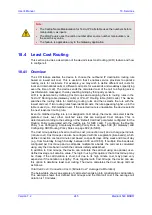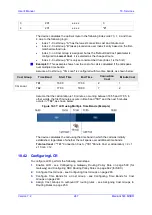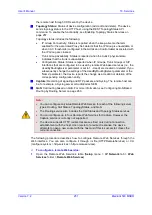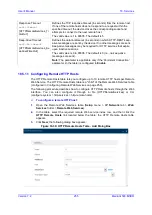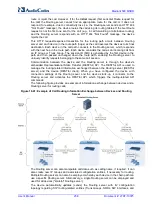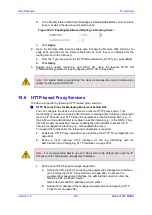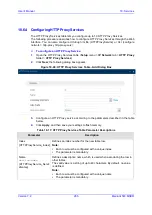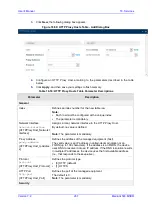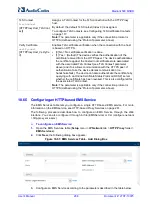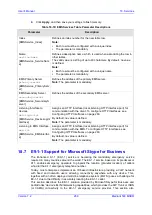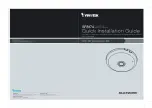
Version 7.2
259
Mediant 500 MSBR
User's Manual
18. Services
IP Groups) that have been configured for use by the Routing server. For example, if you
add a new IP Group and enable it for use by the Routing server, the device sends this
information to the Routing server. Routing of calls associated with routing-related entities
that are disabled for use by the Routing server (default) are handled only by the device (not
the Routing server).
In addition to regular routing, the Routing server also supports the following:
Alternative Routing:
If a call fails to be established, the device "closest" to the failure
and configured to send "additional" routing requests (through REST API -
"additionalRoute" attribute in HTTP Get Route request) to the Routing server, sends a
new routing request to the Routing server. The Routing server may respond with a
new route destination, thereby implementing alternative routing. Alternatively, it may
enable the device to return a failure response to the previous device in the route path
chain and respond with an alternative route to this device. Therefore, alternative
routing can be implemented at any point in the route path. If the Routing server sends
an HTTP 404 "Not Found" message for an alternative route request, the device rejects
the call. If the Routing server is configured to handle alternative routing, the device
does not make any alternative routing decisions based on its alternative routing tables.
Call Status:
The device can report call status to the Routing server to indicate
whether a call has successfully been established and/or failed (disconnected). The
device can also report when an IP Group (Proxy Set) is unavailable, detected by the
keep-alive mechanism, or when the CAC thresholds permitted per IP Group have
been crossed. For Trunk Groups, the device reports when the trunk's physical state
indicates that the trunk is unavailable.
Credentials for Authentication:
The Routing Server can provide user (e.g., IP Phone
caller) credentials (username-password) in the Get Route response, which can be
used by the device to authenticate outbound SIP requests if challenged by the
outbound peer, for example, Microsoft Skype for Business (per RFC 2617 and RFC
3261). If multiple devices exist in the call routing path, the Routing server sends the
credentials only to the last device ("node") in the path.
QoS:
The device can report QoS metrics per IP Group to the Routing server, which
the Routing server can use to determine the best route (i.e., QoS-based routing). For
more information, see Configuring QoS-Based Routing by Routing Server on page
260.
Call Preemption for Emergency Calls:
If you enable call preemption for emergency
calls (e.g., 911) on the device, the routing server determines whether or not the
incoming call is an emergency call and if so, handles the routing decision accordingly
(i.e., preempts a non-emergency call if the maximum call capacity of the device is
reached in order to allow the emergency call to be routed). To enable call preemption
for emergency calls, use the parameter SBCPreemptionMode for SBC calls and
CallPriorityMode for Gateway calls.
To configure routing based on Routing server:
1.
For each configuration entity (e.g., IP Group) that you want routing done by the
Routing server, configure the entity's 'Used By Routing Server' parameter to
Used
:
Figure
18-42: Configuring Entity to Use Routing Server
2.
Configure an additional Security Administrator user account in the Local Users table
(see Configuring Management User Accounts on page 71), which is used by the
Routing server (REST client) to log in to the device's management interface.
3.
Configure the address and connection settings of the Routing server, referred to as a
Remote Web Service and HTTP remote host (see Configuring Remote Web Services
on page 250). You must configure the 'Type' parameter of the Remote Web Service to
Summary of Contents for Mediant 500 MSBR
Page 2: ......
Page 33: ...Part I Getting Started with Initial Connectivity ...
Page 34: ......
Page 36: ...User s Manual 36 Document LTRT 10375 Mediant 500 MSBR This page is intentionally left blank ...
Page 40: ...User s Manual 40 Document LTRT 10375 Mediant 500 MSBR This page is intentionally left blank ...
Page 45: ...Part II Management Tools ...
Page 46: ......
Page 48: ...User s Manual 48 Document LTRT 10375 Mediant 500 MSBR This page is intentionally left blank ...
Page 115: ...Part III General System Settings ...
Page 116: ......
Page 132: ...User s Manual 132 Document LTRT 10375 Mediant 500 MSBR This page is intentionally left blank ...
Page 137: ...Part IV General VoIP Configuration ...
Page 138: ......
Page 290: ...User s Manual 290 Document LTRT 10375 Mediant 500 MSBR This page is intentionally left blank ...
Page 306: ...User s Manual 306 Document LTRT 10375 Mediant 500 MSBR This page is intentionally left blank ...
Page 380: ...User s Manual 380 Document LTRT 10375 Mediant 500 MSBR This page is intentionally left blank ...
Page 454: ...User s Manual 454 Document LTRT 10375 Mediant 500 MSBR This page is intentionallty left blank ...
Page 455: ...Part V Gateway Application ...
Page 456: ......
Page 460: ...User s Manual 460 Document LTRT 10375 Mediant 500 MSBR This page is intentionally left blank ...
Page 484: ...User s Manual 484 Document LTRT 10375 Mediant 500 MSBR This page is intentionally left blank ...
Page 494: ...User s Manual 494 Document LTRT 10375 Mediant 500 MSBR This page is intentionally left blank ...
Page 625: ...Part VI Session Border Controller Application ...
Page 626: ......
Page 654: ...User s Manual 654 Document LTRT 10375 Mediant 500 MSBR This page is intentionally left blank ...
Page 656: ...User s Manual 656 Document LTRT 10375 Mediant 500 MSBR This page is intentionally left blank ...
Page 741: ...Part VII Cloud Resilience Package ...
Page 742: ......
Page 751: ...Part VIII Data Router Configuration ...
Page 752: ......
Page 753: ......
Page 754: ......
Page 756: ...User s Manual 756 Document LTRT 10375 Mediant 500 MSBR This page is intentionally left blank ...
Page 757: ...Part IX Maintenance ...
Page 758: ......
Page 834: ...User s Manual 834 Document LTRT 10375 Mediant 500 MSBR This page is intetnionaly left blank ...
Page 837: ...Part X Status Performance Monitoring and Reporting ...
Page 838: ......
Page 848: ...User s Manual 848 Document LTRT 10375 Mediant 500 MSBR This page is intentionally left blank ...
Page 852: ...User s Manual 852 Document LTRT 10375 Mediant 500 MSBR This page is intentionally left blank ...
Page 854: ...User s Manual 854 Document LTRT 10375 Mediant 500 MSBR This page is intentionally left blank ...
Page 878: ...User s Manual 878 Document LTRT 10375 Mediant 500 MSBR This page is intentionally left blank ...
Page 880: ...User s Manual 880 Document LTRT 10375 Mediant 500 MSBR This page is intentionally left blank ...
Page 926: ...User s Manual 926 Document LTRT 10375 Mediant 500 MSBR This page is intentionally left blank ...
Page 927: ...Part XI Diagnostics ...
Page 928: ......
Page 950: ...User s Manual 950 Document LTRT 10375 Mediant 500 MSBR This page is intentionally left blank ...
Page 954: ...User s Manual 954 Document LTRT 10375 Mediant 500 MSBR This page is intentionally left blank ...
Page 956: ...User s Manual 956 Document LTRT 10375 Mediant 500 MSBR This page is intentionally left blank ...
Page 958: ...User s Manual 958 Document LTRT 10375 Mediant 500 MSBR This page is intentionally left blank ...
Page 974: ...User s Manual 974 Document LTRT 10375 Mediant 500 MSBR This page is intentionally left blank ...
Page 976: ...User s Manual 976 Document LTRT 10375 Mediant 500 MSBR This page is intentionally left blank ...
Page 977: ...Part XII Appendix ...
Page 978: ......
Page 982: ...User s Manual 982 Document LTRT 10375 Mediant 500 MSBR This page is intentionally left blank ...

